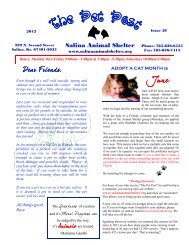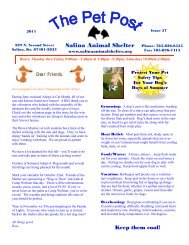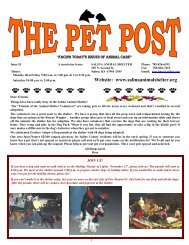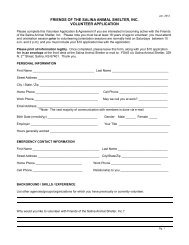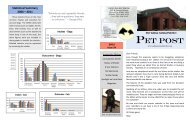PET MEMORIALS - Salina Animal Shelter
PET MEMORIALS - Salina Animal Shelter
PET MEMORIALS - Salina Animal Shelter
Create successful ePaper yourself
Turn your PDF publications into a flip-book with our unique Google optimized e-Paper software.
WATER – IT’S ESSENTIAL<br />
Many loving, good-hearted pet owners spend a lot of time<br />
and energy making sure their pet has a healthy diet,<br />
considering brands, comparing labels, debating moist-versusdry,<br />
and consulting their veterinarian. In all the hubbub, they<br />
sometimes forget that an ever-present bowl of clean water<br />
may be the most important part of their pet’s diet.<br />
Why is it important? In pets, as in people, water makes up<br />
the majority of the body about 80 percent. By allowing<br />
substances to dissolve and be carried through the body, it<br />
provides a basis for nearly all of the processes and chemical<br />
reactions that keep the body running, including digestion and<br />
circulation. It helps the body to filter out waste, and it<br />
regulates body temperature through evaporation.<br />
Dehydration, a lack of water in the body, can cause serious<br />
problems, including kidney and heart damage.<br />
What should I do? As vital as water is, it’s relatively easy<br />
to provide. Just make sure your pet has a clean bowl (or<br />
bottle, in the case of some smaller animals) of fresh water at<br />
all times. A general rule of thumb is that most animals<br />
should have about 28 milliliters (or one fortieth of a liter) of<br />
water per pound of body weight per day. A forty-pound dog<br />
needs about a liter of water every day; a ten-pound cat needs<br />
about a quarter of a liter. You don’t need to spend time<br />
crunching the numbers, though. Most healthy animals that<br />
have access to clean water will drink enough to keep them<br />
hydrated.<br />
If you’re worried that your pet isn’t drinking enough, or you<br />
see signs of dehydration like depression, sunken eyes or dry<br />
gums, take your little furry guy to the veterinarian. If your<br />
pet’s dehydrated, your veterinarian can give him intravenous<br />
fluids and find out what caused the problem.<br />
Common Pitfalls<br />
Though water seems like a simple enough subject, a few<br />
common problems can leave pets high and dry:<br />
• The water bowl or water bottle needs cleaning every<br />
day. Bacteria that you can’t see can grow in a bottle<br />
or bowl, giving the water a funny taste and<br />
discouraging your pet from drinking. Even worse,<br />
some kinds of bacteria can make animals sick.<br />
Develop the habit of giving the bowl a quick scrub<br />
with dish soap before you fill it in the morning.<br />
Pocket pets’ handing water bottles can be particularly<br />
hard to get clean; you may want to buy a long, narrow<br />
scrub brush that can fit through the bottle’s neck and<br />
clean the inside.<br />
• Dogs and cats that are left alone for long periods can<br />
easily knock over their water bowls. Try buying a<br />
bowl with a wide, weighted bottom. You may also<br />
want to leave more than one bowl around the house:<br />
one in the bathroom for example, and another in the<br />
kitchen.<br />
• Water evaporates faster than you may realize,<br />
particularly on warm days. Check water bowls a few<br />
times a day, especially in the summer. If your pet’s<br />
outside on a very hot day, check the water every hour.<br />
• You may think you’re helping your pet out by setting<br />
out a big bucket filled with water, but once the<br />
9<br />
bucket’s half empty he may not be able to get to the water<br />
anymore. Cats and small dogs could even fall in while<br />
drinking. Before you use a water bucket, make sure your pet’s<br />
neck is long enough to allow him to drink from the bottom of<br />
it.<br />
• Dogs that are chained up can easily wind the chain<br />
around a tree, a post, or even their own legs. With a<br />
tangled chain, they can’t get to their water bowl. If you<br />
have to leave your pet chained outdoors, check him<br />
often.<br />
• Lots of dogs and cats see the toilet as a big water<br />
fountain. Keep the toilet lid closed, because the bacteria<br />
in toilet water can make animals sick and, as with large<br />
buckets, cats and small animals can fall in while<br />
drinking. Even the best of us can forget to close the lid<br />
every once in a while, though, so don’t use drop-in<br />
cleaners that release chemicals into the toilet bowl.<br />
These chemicals may be toxic.<br />
• Some exotic animals, particularly amphibians like frogs<br />
and salamanders, can’t or won’t drink water from a<br />
bowl. These guys need a drip watering system, which<br />
drips or sprays temperature-controlled moisture into a<br />
cage for a few hours at a time. To select the right<br />
watering system for your exotic pet, consult your<br />
veterinarian.<br />
• Reptiles often need a long, shallow dish of water in their<br />
cages. They use this water both to drink and to soak in,<br />
so it needs to be checked several times a day for dirt or<br />
fecal matter.<br />
• Just like you, pets need more water when they’re<br />
exercising. If you take your dog out for a long walk or<br />
run, bring along some water for him. Most pet stores<br />
sell light, collapsible travel water bowls that are easy to<br />
carry.<br />
“I would never, ever adopt another pet<br />
without going to a shelter to do it. I am a<br />
changed woman after seeing this show.”<br />
Oprah Winfrey<br />
After airing a show on puppy mills.<br />
Doggie Ice Cream<br />
2 cups vanilla yogurt<br />
Mashed bananas<br />
2 tablespoons honey<br />
Mix ingredients and freeze in<br />
ice cube tray. Viola … sweet,<br />
cool bite size treats for your<br />
pooch!



